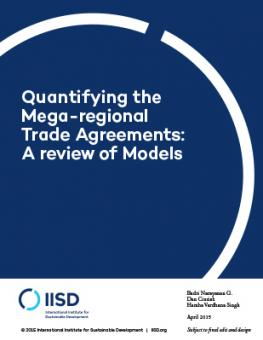
Quantifying the Mega-regional Trade Agreements: A review of Models
Major developments in trade policy are currently taking place in the mega-regional trade agreements, in particular in the Trans-Pacific Partnership, the Trans-Atlantic Trade and Investment Partnership, and the Trade in Services Agreement.
These agreements are setting new standards and breaking new ground in setting the rules for global commerce. In addition, a large number of other agreements are incorporating state-of-the-art provisions governing at least some aspects of trade and investment. These include the Regional Comprehensive Economic Partnership, the Tripartite Free Trade Agreement, and a large number of bilateral trade and investment agreements. Complementing and internalizing the recent WTO Trade Facilitation Agreement, these agreements are introducing new WTO-plus rules for services and investment, addressing emerging issues, such as electronic commerce and the role of state-owned enterprises, and introducing whole new subject areas to agreements. There is deep interest in understanding the impact of these new developments, both on the part of policy makers in countries that are party to the negotiations and in countries that are excluded, but which will nonetheless be affected by the new standards and rules. Traditional quantitative trade models are being adapted to provide comprehensive answers. This paper reviews these models and considers the extent to which they capture the full effects of the new age agreements. We find that the most comprehensive approach to modelling the mega-regionals is to employ a Computable General Equilibrium model of the type used for multi-sector, multi-region trade analysis. These are the only models with sufficient structural features to capture the main focus areas of the mega-regionals, namely services, investment, and the new ― behind the border‖ issues, while still covering the traditional areas of liberalization, such as tariffs and at least some features of agricultural trade. However, given the wide range of CGE models with different features, inevitably the impact of mega-regionals is probably best captured by meta-analysis of a suite of CGE-based studies, drawing on satellite models for additional structural detail and on sufficient statistics estimates as reality checks.
You might also be interested in
A Sustainable Asset Valuation Assessment of Building and Transport Infrastructure Investment in the Shymkent-Tashkent-Khujand Economic Corridor
This report presents the Sustainable Asset Valuation (SAVi) of a proposed transport and building infrastructure development on the border of Kazakhstan and Uzbekistan to promote close and mutually beneficial trade relationships between the countries.
WTO Agriculture Negotiations at MC13: What does the lack of outcomes mean for least developed countries and other vulnerable economies?
IISD expert Facundo Calvo analyzes what came out of the WTO's agriculture negotiations at the 13th Ministerial Conference in Abu Dhabi and its implications for least developed countries and other vulnerable economies.
IISD experts on MC13 outcomes
IISD experts react to the outcomes and conclusions of negotiations at the Thirteenth Ministerial Conference of the World Trade Organization (MC13) (WTO).
Global Market Report: Soybean prices and sustainability
Less than 3% of soybeans are produced in compliance with sustainability standards. This report unpacks what needs to change to make soybeans a food that protects rather than harms the natural environment.